- Home
- About Us
- Industry
- Services
- Reading
- Contact Us
Southeast Asia Two-Wheeler Market: Current Analysis and Forecast (2023-2030)
Emphasis on Propulsion Type (ICE Vehicles {Below 50 cc, 100-250 cc, and Above 250 cc})and Electric Vehicles); Vehicle Type (Motorcycle and Scooters) and Region/Country
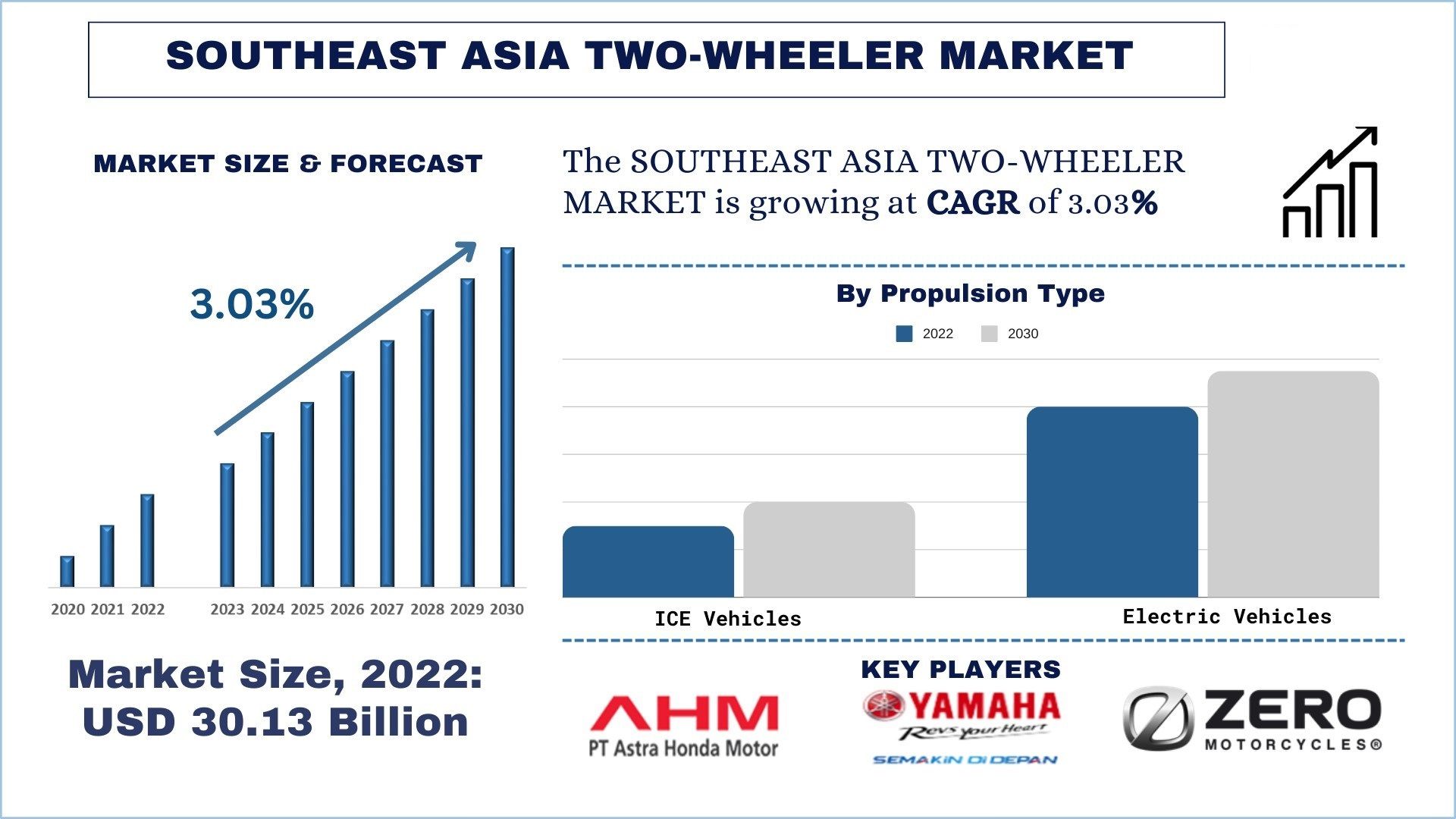
Southeast Asia Two-Wheeler Market Size & Forecast
The Southeast Asia Two-Wheeler Market was valued at USD 30.12 Billion and is expected to grow at a strong CAGR of around 3.03% during the forecast period (2023-2030) owing to rising air traffic worldwide and safety concerns.
Southeast Asia Two-Wheeler Market Analysis
The public transportation infrastructure in numerous Southeast Asian cities is currently in the process of development, resulting in gaps in coverage and limited connectivity to specific areas. Two-wheelers play a crucial role as a means of last-mile connectivity, bridging the distance between public transport hubs and final destinations. In nations such as Thailand and the Philippines, motorcycle taxis, referred to as “habal-habal” or “motorcycle taxis,” are a popular option for short-distance travel, particularly in locations where traditional taxis or ride-sharing services may not be easily accessible. This dependence on two-wheelers for last-mile connectivity fuels the demand for motorcycles and scooters in the region. Furthermore, the rise of food delivery services and e-commerce platforms has further boosted the demand for two-wheelers in Southeast Asia. Delivery riders rely on motorcycles and scooters to fulfill orders quickly and efficiently, contributing to the overall growth of the market.
Some of the Major Players
Some of the major players operating in the market include PT Astra Honda Motor, Yamaha Indonesia Motor Mfg., Thai Yamaha Motor Co., Ltd., Honda Motor Co., Ltd., Yamaha Motor Vietnam Co., Ltd., Kawasaki Motors, Ltd., Zero Motorcycles Inc., Hero Electric Vehicles Pvt. Ltd, Vmoto Ltd., and AIMA Technology Group Co. Ltd. Several M&As along with partnerships have been undertaken by these players to facilitate customers with hi-tech and innovative products/technologies.
Southeast Asia Two-Wheeler Market Trends
Favorable Government Policies and Incentives
Governments in nations such as Indonesia, Thailand, Vietnam, and Malaysia have implemented a range of incentives and regulations to promote the adoption of electric two-wheelers. These measures encompass tax breaks, subsidies, and waivers for registration fees and road taxes. For example, the Thai government provides subsidies of up to 18,000 baht (around USD 500) for the purchase of electric motorcycles. Similarly, Indonesia has established a goal of manufacturing 2.5 million electric motorcycles annually by 2035.Furthermore, the rising recognition of the ecological consequences caused by conventional gasoline-powered automobiles has led consumers in Southeast Asia to become more mindful of their carbon footprint. Electric two-wheelers present a sustainable option, as they produce no direct emissions and entail considerably lower operational expenses in comparison to their gasoline counterparts. This increasing environmental awareness, especially among younger age groups, is fueling the desire for electric two-wheelers.
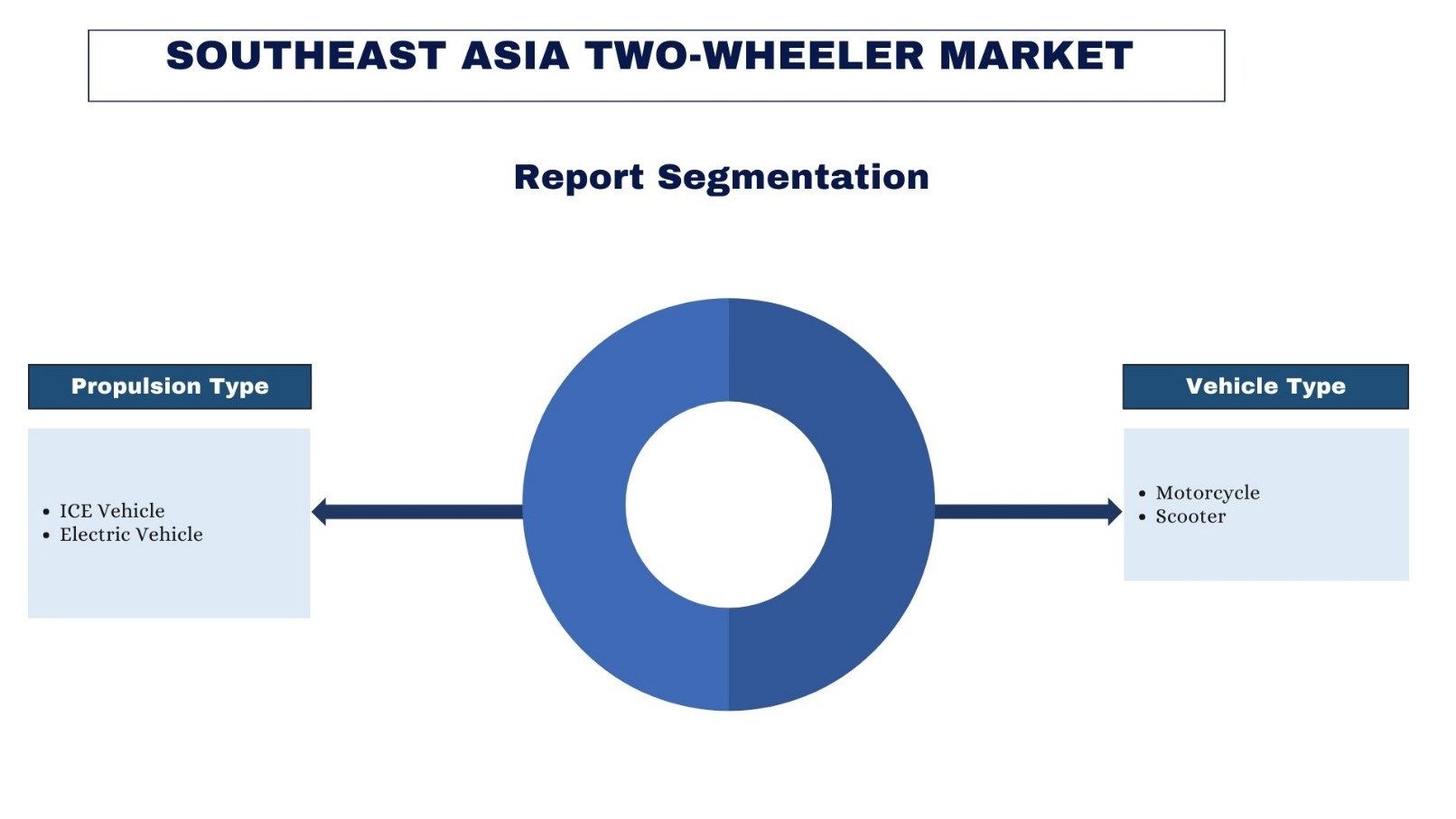
Indonesia Dominated the Southeast Asia Two-Wheeler Market
Indonesian market has dominated the two-wheeler market and is expected to behave in the same fashion due to the large consumer base. As Indonesia is the world’s fourth-most-populous country in the world with 279 million people residing in the country. Additionally, due to the increasing demand for economic transportation mode and improved road infrastructure the demand for two-wheelers has increased in the last couple of years. For instance, according to the report published by “The Association of Indonesia Motorcycle Industry (AISI)” a total of 521,424 units sold in the March 2021 which increased to 592,658 units sold in January 2024. Additionally, the Indonesian government tightening its monetary policy, making financing for motorcycle purchases harder. Furthermore, mobility service providers growing rapidly in Indonesia like Gojek, Tokopedia and Bluebird, which accelerated the demand in motorcycles and passenger cars parallelly over the past decade.
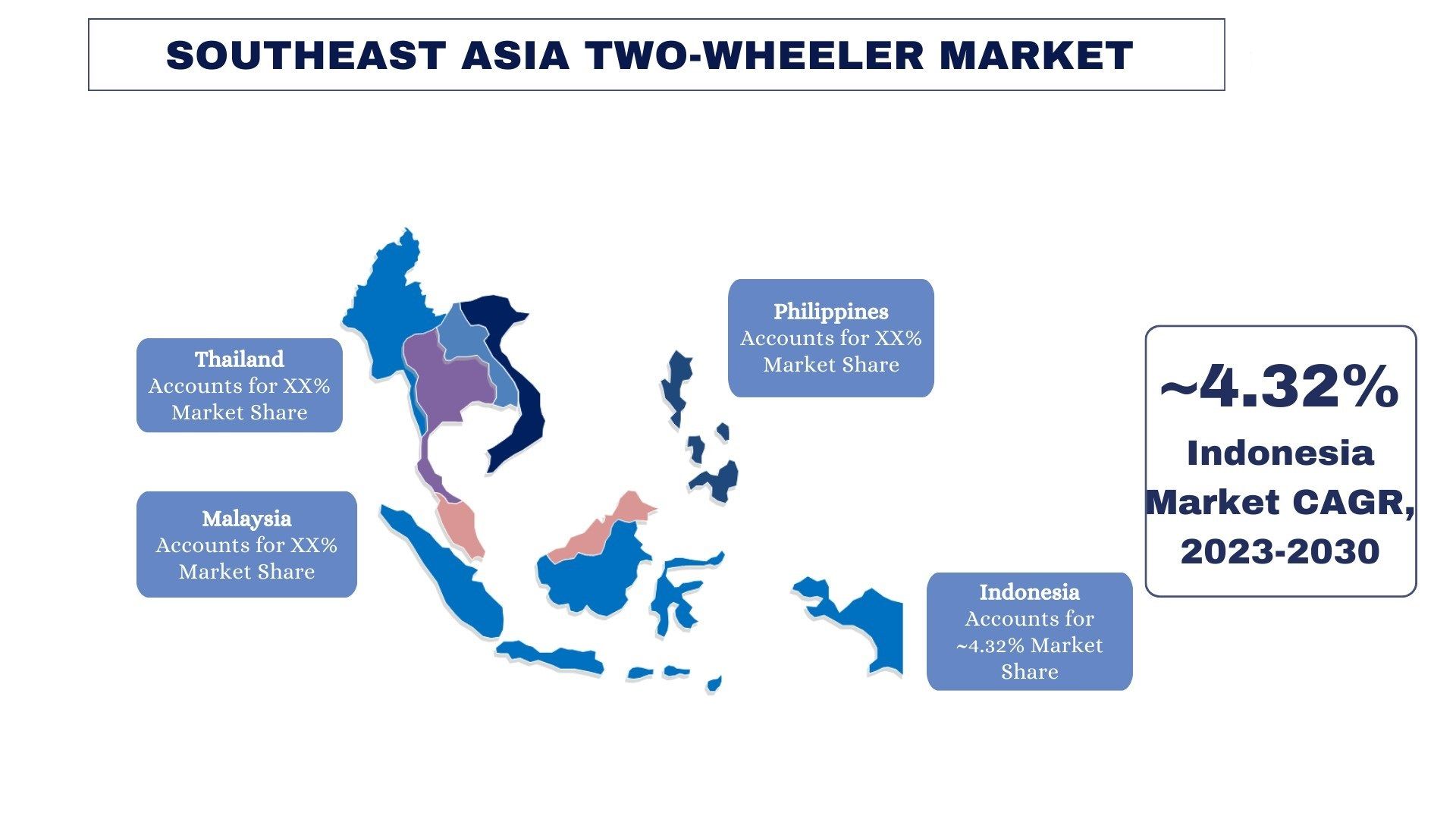
Southeast Asia Two-Wheeler Market Report Coverage
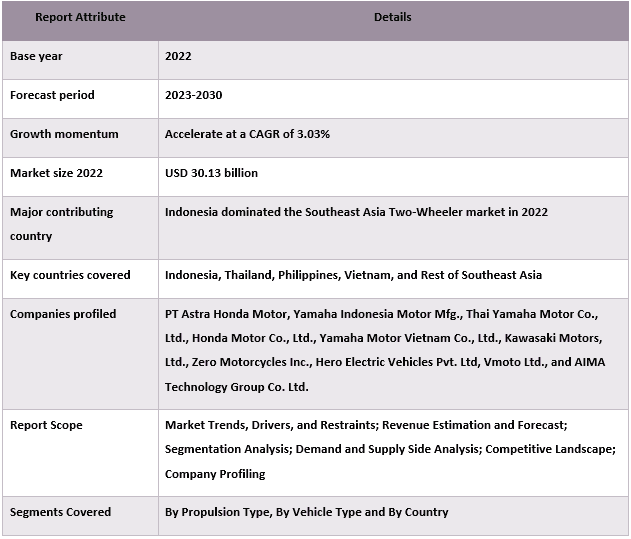
Reasons to buy this report:
- The study includes market sizing and forecasting analysis validated by authenticated key industry experts.
- The report presents a quick review of overall industry performance at one glance.
- The report covers an in-depth analysis of prominent industry peers with a primary focus on key business financials, product portfolios, expansion strategies, and recent developments.
- Detailed examination of drivers, restraints, key trends, and opportunities prevailing in the industry.
- The study comprehensively covers the market across different segments.
- Deep dive regional level analysis of the industry.
Customization Options:
The Southeast Asia Two-Wheeler market can further be customized as per the requirement or any other market segment. Besides this, UMI understands that you may have your own business needs, hence feel free to contact us to get a report that completely suits your requirements.
Table of Content
Research Methodology for the Southeast Asia Two-Wheeler Market Analysis (2023-2030)
Analyzing the historical market, estimating the current market, and forecasting the future market of the Southeast Asia Two-Wheeler market were the three major steps undertaken to create and analyze the adoption of two-wheelers in major regions in Southeast Asia. Exhaustive secondary research was conducted to collect the historical market numbers and estimate the current market size. Secondly, to validate these insights, numerous findings and assumptions were taken into consideration. Moreover, exhaustive primary interviews were also conducted, with industry experts across the value chain of the southeast Asia two-wheeler. Post assumption and validation of market numbers through primary interviews, we employed a top-down/bottom-up approach to forecasting the complete market size. Thereafter, market breakdown and data triangulation methods were adopted to estimate and analyze the market size of segments and sub-segments of the industry pertains to. Detailed methodology is explained below:
Analysis of Historical Market Size
Step 1: In-Depth Study of Secondary Sources:
A detailed secondary study was conducted to obtain the historical market size of the Southeast Asia Two-Wheeler market through company internal sources such as annual reports & financial statements, performance presentations, press releases, etc., and external sources including journals, news & articles, government publications, competitor publications, sector reports, third-party database, and other credible publications.
Step 2: Market Segmentation:
After obtaining the historical market size of the southeast Asia two-wheeler market, we conducted a detailed secondary analysis to gather historical market insights and share for different segments & sub-segments for major regions. Major segments are included in the report such as propulsion type, vehicle type. Further country-level analyses were conducted to evaluate the overall adoption of testing models in that region.
Step 3: Factor Analysis:
After acquiring the historical market size of different segments and sub-segments, we conducted a detailed factor analysis to estimate the current market size of the southeast Asia two-wheeler market. Further, we conducted factor analysis using dependent and independent variables such propulsion type, and vehicle type of the southeast Asia two-wheeler market. A thorough analysis was conducted of demand and supply-side scenarios considering top partnerships, mergers and acquisitions, business expansion, and product launches in the Southeast Asia Two-Wheeler market sector across the globe.
Current Market Size Estimate & Forecast
Current Market Sizing: Based on actionable insights from the above 3 steps, we arrived at the current market size, key players in the Southeast Asia Two-Wheeler market, and market shares of the segments. All the required percentage shares split, and market breakdowns were determined using the above-mentioned secondary approach and were verified through primary interviews.
Estimation & Forecasting: For market estimation and forecast, weights were assigned to different factors including drivers & trends, restraints, and opportunities available for the stakeholders. After analyzing these factors, relevant forecasting techniques i.e., the top-down/bottom-up approach were applied to arrive at the market forecast for 2030 for different segments and sub-segments across the major markets. The research methodology adopted to estimate the market size encompasses:
- The industry’s market size, in terms of revenue (USD) and the adoption rate of the Southeast Asia Two-Wheeler market across the major markets domestically.
- All percentage shares, splits, and breakdowns of market segments and sub-segments.
- Key players in the southeast Asia two-wheeler in terms of products offered. Also, the growth strategies adopted by these players to compete in the fast-growing market.
Market Size and Share Validation
Primary Research: In-depth interviews were conducted with the Key Opinion Leaders (KOLs) including Top Level Executives (CXO/VPs, Sales Head, Marketing Head, Operational Head, Regional Head, Country Head, etc.) across major regions. Primary research findings were then summarized, and statistical analysis was performed to prove the stated hypothesis. Inputs from primary research were consolidated with secondary findings, hence turning information into actionable insights.
Split of Primary Participants in Different Regions
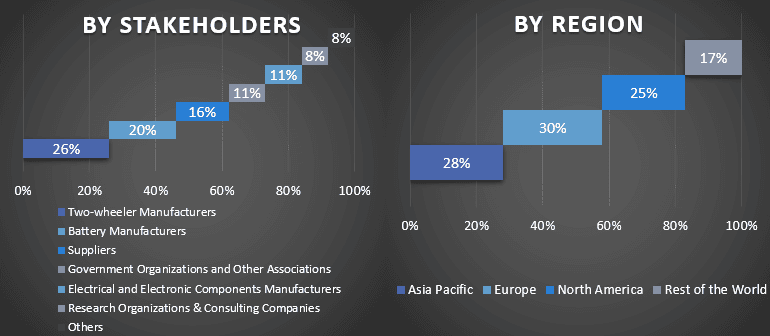
Market Engineering
The data triangulation technique was employed to complete the overall market estimation and to arrive at precise statistical numbers for each segment and sub-segment of the Southeast Asia Two-Wheeler market, data was split into several segments & sub-segments after studying various parameters and trends in the area’s propulsion type and vehicle type in the southeast Asia two-wheeler.
The main objective of the Southeast Asia Two-Wheeler Market Study
The current & future market trends of the Southeast Asia Two-Wheeler market were pinpointed in the study. Investors can gain strategic insights to base their discretion for investments on the qualitative and quantitative analysis performed in the study. Current and future market trends determined the overall attractiveness of the market at a regional level, providing a platform for the industrial participant to exploit the untapped market to benefit from a first-mover advantage. Other quantitative goals of the studies include:
- Analyze the current and forecast market size of the southeast Asia two-wheeler market in terms of value (USD). Also, analyze the current and forecast market size of different segments and sub-segments.
- Segments in the study include areas of propulsion type and vehicle type.
- Define and analyze the regulatory framework for the southeast Asia two-wheeler
- Analyze the value chain involved with the presence of various intermediaries, along with analyzing customer and competitor behaviors of the industry.
- Analyze the current and forecast market size of the southeast Asia two-wheeler market for the major region.
- Major countries of regions studied in the report include Indonesia, Thailand, Philippines, Vietnam and Rest of Southeast Asia.
- Company profile of the southeast Asia two-wheeler market and the growth strategies adopted by the market players to sustain in the fast-growing market.
- Deep dive regional level analysis of the industry
Frequently Asked Questions FAQs
Q1: What is the current market size and growth potential of the Southeast Asia Two-Wheeler market?
Q2: What are the driving factors for the growth of the Southeast Asia Two-Wheeler Market?
Q3: Which segment has the largest share of the Southeast Asia Two-Wheeler market by propulsion type?
Q4: What are the emerging technologies and trends in the Southeast Asia Two-Wheeler market?
Q5: Which country will dominate the Southeast Asia Two-Wheeler market?
Q6: Who are the key players operating in the Southeast Asia Two-Wheeler market?
Related Reports
Customers who bought this item also bought










